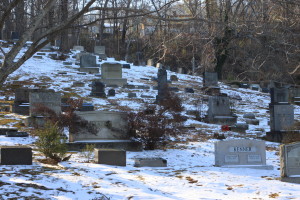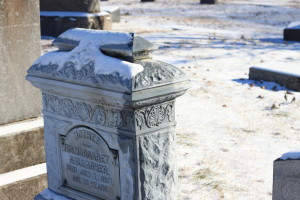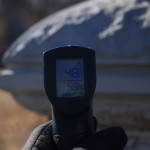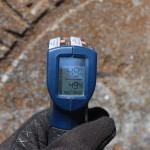
Snowfall helps cemetery explorers discover zinc grave markers.
Do you enjoy searching for your favorite types of tombstones when exploring cemeteries?
Whether you like searching for wood, granite, slate, marble, or sandstone grave markers, spotting your favorite stele from a distance is always fun. Personally, I enjoy seeking zinc grave markers, among others.
Zinc grave markers are easily identified by the trained eye. In fact, with a quick scan across a large monument laden cemetery, even hobbyists can quickly find zinc markers. They just look different. There is something about their muted grey color that catches your eye and makes you linger a ½ second longer trying to figure out why that particular “tombstone” looks slightly different from the others.
I explored a new cemetery with a friend last summer. Her interest in cemeteries is new and budding. “See that marker over there? It’s metal.” I told her. “How do you know it is metal?” She asked. I told her to tap on it with her knuckles. She was amazed at the hollow “DING” that rang out but more than that she was amazed that I had used some “trick” to spot it more than 100 feet away amongst a sea of other markers.
Zinc grave markers have an interesting history. They were produced by the Monumental Bronze Company toward the last decade of the 1800’s and the first decade of the 1900’s. At first, the markers were not popular with families of the newly deceased. However, clever marketing by Monumental Bronze let families know of zinc’s affordability, long life, and easy maintenance. One other strategy used by Monumental Bronze was a change in name from “Zinc” to “White Bronze.” White Bronze markers became thought of as progressive for the new century and thousands were sold and installed in cemeteries all across the United States.
So, what is it about zinc markers that makes them readily identifiable from afar? Is it their subdued reflection of sunlight? Is it their distinguished removable panels? Is it their powdery appearance? I don’t know what it is but I do know that I recently discovered yet another method of finding zinc grave markers.
You probably saw on the news that we received quite a bit of snowfall at the end of January. Once the roads cleared, I trekked to a few cemeteries to check on grave sites. A zinc marker was along my path and I noticed snow appeared to be melting at a greater rate on the zinc marker than on nearby granite markers. My initial hypothesis was that the zinc marker absorbed sunlight a greater rate than the granite markers. With a quick check of my temperature gun, my hypothesis proved inconclusive since the zinc grave marker and two adjacent granite grave markers were of very similar temperatures.
What other factors could be at play? Since the heat capacity of a granite marker is much greater than a similarly sized zinc marker is it possible that granite takes longer to heat up and allows the snow to hang around longer? Did crinkled surface with lots of bends and different angles on the zinc marker better absorb sunlight? Or, was it a simple case of the snow melting equally on each marker but the wetness of melted snow dripping made a more dramatic color differential on zinc than it did on the granite markers?

Well, I am not sure of the answer but I do know that I now I have another “trick” to amaze friends when exploring cemeteries and looking for zinc markers.
What are your “tricks” when determining composition of grave markers? Feel free to leave a response below to let me know your favorite type and style of tombstone. What “tricks” or cool info do you know about them?
If you love tombstones and cemeteries, you might really enjoy starting your own Grave Care Business. I love cemeteries and I love being able to work in and explore new cemeteries all the time. If you are thinking about starting a Grave Care Business, my company has developed a Grave Care Business Course that will help you start and grow a successful Grave Care Business. The course includes a huge grouping of manuals, guidebooks, tutorials, video training, business tools, and estimating software.
For more information on the Grave Care Business Course, please visit our website: www.GraveCareBusiness.com
.



